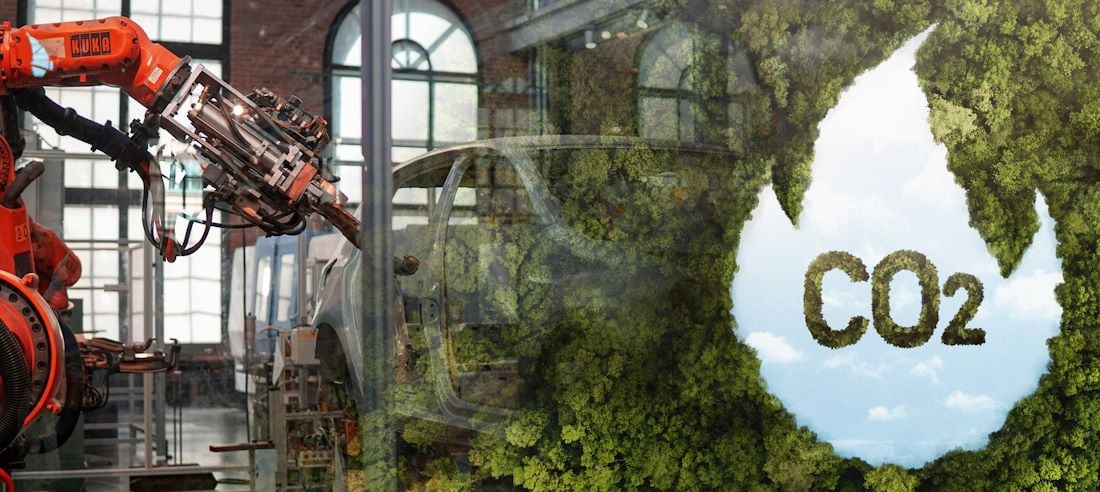Throughout its lifespan, a building affects the environment in a multitude of ways. How our house is built, how we live in it, and what climate it stands in, has an unbelievably big impact on our personal carbon footprint. Roughly a third of all human carbon dioxide emissions come from buildings! The method of construction plays a big role, of course. Quite obviously, building a building requires piles of energy. Not only human energy (the countless harmonious couples who owe their separation to the unforeseen hassles involved in house building provide a dramatic illustration…), but also actual physical energy. The making, transport and assembly of all building materials, especially concrete and metal, is already energy intensive. However, not only in materials, but also in use, buildings consume energy. Actually, the way the building is put together and the demands of the humans who live and work inside it determine the amount of energy that is required in the building’s use phase. Taking into account the importance of a cozy home and a productive working environment on the one hand, and the rising awareness of energy conservation on the other, it is only natural that topics like green housing, sustainable construction and zero-energy houses receive a lot of attention. How green has the construction sector become? Do the current standards for measuring green buildings work? How can they be improved? Who are the global leaders? What challenges do they still face?
Building Certification Based on Lists of Qualitative Measures or on Energy Consumption Per Unit Area?
Certification is a popular instrument to encourage energy efficiency improvements in buildings – popular with authorities above all, and, provided they are voluntary, also popular with house builders. In the United States, the best-known certification system is called LEED: Leadership in Energy and Environmental Design. Its silver, gold and platinum standards refer to an array of properties a so-called green building can have. The extensive rating scheme behind LEED contains huge lists. Depending on the number of “green features” a certain building has to offer, it is awarded a score on a predefined scale. You can find all scales as a PDF download by clicking “rating scale” in the right column at the linked LEED page. Possible points for homes, for instance, are earned if 80% of it’s lamps are energy-star rated, if the car park is beneath the house or under a “vegetated deck”, or if a rainwater tank is used. In Europe, such amply endowed, qualitative schemes are not widespread. Instead, quantitative measures like annual energy consumption per square meter form a part of the most used standards. Arguments why standards make sense, both quanti– and quali– tative ones, can be found in the International Energy Agency’s “Policy Pathway” for the “Energy Performance Certification of Buildings” (PDF):
Direct benefits associated with building certification schemes include: energy and CO2 emissions reductions and broader environmental benefits; increased public awareness of energy and environmental issues; lower costs for users; and improved data on buildings, which can be used for future policy development to further improve energy efficiency in the building stock.
Good Ratings Suggest How to Improve Efficiency
In most countries, several rating systems for buildings compete to earn builder’s and investor’s favor. So globally, it seems like there are more ratings than stars in the sky. Yet a label can only be meaningful when what it stands for is known to the target audience (mostly house builders, tenants, and investors, but also regulators). Additionally, it should encourage future improvements not only in the actual building that gets certified, but also in the renovation or construction of other houses as well. The above-mentioned IEA publication merits Denmark for employing such a label, shown on page 15 of the Policy Pathway PDF:
It is increasingly apparent that it is the advice on energy efficiency improvements, rather than a rating, that mobilises the market to deliver energy savings measures and to achieve reductions in the building sector carbon emissions (ECEEE, 2009). The specificity of the information provided is important in determining whether the building owners implement the advice. The more specific the recommendation, the larger the impact – but the costs of the advice may be higher.
Most Passive Houses in Alpine Countries, Strictest Standards in Scandinavia
It is natural that in places with a harsh winter, higher building standards are more commonly set. That is not surprising since better insulation pays off when heating costs are higher. Scandinavia, together with the German-speaking region, are not necessarily the parts of the world where absolute temperature records are reported. However, winters in these regions are cold, and they are definitely the places with the highest number of newly built or refurbished low-energy and zero-emission buildings. Austria, Switzerland and Germany have seen passive houses spread like wildfire – no wonder, once you have experienced the unpretentious use and unprecedented coziness a heat retaining shell of thick walls and triple-glazed windows can bring. As the Danish example shows, Scandinavia is an efficiency hotspot, too. By law, Sweden’s public buildings have to match mandatory GRI sustainability reporting standards. Thus, it is no exaggeration to call Sweden a world leader in sustainable construction. But even world leaders are far from being perfect, if we are to believe Pernilla Hagbert, Mikael Mangold and Paula Femení. The three researchers from Göteborg’s Chalmers University of Technology published an article on the “Paradoxes and Possibilities” of the green building sector in Sweden. Their analysis in the form of a qualitative study circled around a state-of-the-art urban development project in Göteborg’s Kvillebäcken district. It was based on extensive interviews with representatives of six major construction companies involved in the project and published in the last MDPI Sustainability Journal. Using academic terms, they put my introductory paragraph into a few, concise words:
The building sector—and the myriad of supporting sectors connected to it—is a main contributor to the environmental stress and resource depletion of modern society.
Hagbert, Mangold and Femeni confirmed that “green-ness” plays an increasingly big part when it comes to buildings, not only in Sweden, but all over the world:
Since the latter part of the last decade, sustainability has increasingly been part of the general agenda in the Swedish building sector [12,13]. This development is mainly driven by anticipated regulation for European Energy Performance, along with national energy/environmental goals, and local environmental policies in metropolitan areas. It is further supported also on a global scale by an increased competence for these issues within the sector, a push for certification systems, and the formulation of green strategies among housing developers around the world, as a response to a growing market for such competitive distinction both nationally and internationally [14].
How Much Carbon Does Wood Fiber Store?
Just like the Danish label that suggests measures for efficiency improvements, construction companies who calculate the carbon footprints of their projects thereby find ways to reduce their emissions. A wood processing company from Germany, e.g., found that while the production and installation of a wooden roof truss sets free almost 10 metric tons of carbon dioxide, the same roof also permanently stores 64 tons CO2. Because the company processes its own wood solely with renewable energy, its building activities are technically carbon negative. For the time their frames and roofs remain in place, the material sequesters all carbon that was captured before the growing tree was cut and transformed into wooden construction material. My article on carbon footprinting and energy management tells you more about that.
Efficiency Alone not Enough to be Sustainable
So far, it all sounds remarkably positive. But don’t get me wrong. Just because it has a common Germanic language origin, it doesn’t mean northern Europe is united in absolute sustainability. Actually, although constant progress is made, things are not as idyllic as they seem. Take Hagbert et. al. as an example. No matter how advanced their own country may be in terms of energy-efficient housing, the Swedish researchers complain about the lack of interest in social sustainability and holistic eco-approaches:
[W]hile energy efficiency, and in part environmental preferences regarding material choices are considered, the social dimension of sustainability as well as other impacts of the built environment on ecological systems is still overlooked [3,15].
I imagine that they have other measures in mind that go beyond the single dimension of energy consumption or carbon emissions. One single dimension won’t get us any further, we can conclude. Does that ring a bell?
As I wrote in a related article, the destination of human development should be to drive on a multi-lane sustainability highway. And if it does so, a “Balanced Mix of Technologies and Strategies” is of utmost importance. So what else did the Swedes discover? In the quest for a holistic approach, they call for systems thinking:
In order to avoid paradoxical discourses and sub-optimal progress in the building sector, a holistic perspective on sustainable development including dimensions of social capital and equal opportunities linked with an ecological modernization perspective is needed. This holistic perspective must also entail a systems thinking on multiple levels to take rebound effects and individuals‘ opportunities for engagement and prioritizations into account. Socio-cultural aspects of the built environment, along with affordability, remain important issues to be incorporated.
Systems Thinking, Clear Definitions, Local + Personal Responsibility
Multiple levels, dynamic models, systems thinking. How can that be accomplished? Knowtheflow has already assembled seven all-encompassing articles illustrating the holistic “systems” perspective and concrete examples for what that rather vague term represents. Meanwhile, our researchers in Sweden called for improving regulatory efforts and a generally more consistent definition of what sustainability implies:
A clarification and strengthening of policy is essential, yet continues to be regarded as problematic in a market-environmentalist paradigm. There is nonetheless a need for an alignment between how industry, policy and the market perceive housing development and what is actually sustainable. This goes beyond the contemporary discourse on efficiency—what and how to sustain—and the current social target groups—for whom and what to develop. Such a discourse would move focus from efficiency to sufficiency. (…)
In summary, it is argued that the market on its own is not delivering holistically sustainable living environments, but rather work from an interpretation of sustainability with a limited reach. Instead, local and personal responsibility and initiatives taken within the housing sector can be found to have greater impact on the development of sustainable housing. Developing both policy and practice, as well as emphasizing collaboration for a more holistic discourse, is proposed.
“Local and personal responsibility”? Looks like a boring task, at first sight. But as a Netherlands research team was able to show, caring for the planet actually makes you happy. Well, three pages of academic insights later, and we know better than ever before that all this planet and its buildings need are people who take responsibility.
Article image by Gavin Schaefer (GS+), CC BY 2.0. It shows the LEED-Platinum-awarded Cooper Union “New Academic Building” in New York City. Read more about it here or here.





